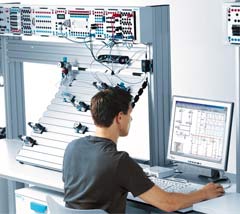Pneumatic Training
Pneumatic Training aims to familiarise delegates with the design, construction and operation of pneumatic components. This includes the interpretation of circuit diagrams and symbols as well as the construction of control systems.
This pneumatic training covers the use of compressed air for pneumatic control and as a signalling medium. A complete overview is given, covering compressors, storage, dryers and distribution as well as the design, construction and operation of a range of Actuators, Valves and ancillary equipment. Practical sessions give delegates the opportunity to put theory into practice. Working from the diagrams they have produced, delegates have to select the correct components from a range of equipment and build the circuits, making the necessary adjustments for pressure, flow and sequence.A strong emphasis is placed on safety and appropriate working practices throughout the course, especially during the practical sessions. All personnel involved with the design, installation, maintenance, operation and servicing of industrial pneumatic equipment and basic control systems will attend the training.
A general engineering background is advised but no specific knowledge of pneumatics is needed as this will be covered within the pneumatic training course.
Content
- Advantages and disadvantages of air
- SI units and conversions
- Theory of air and gas laws
- Overview of compressors, dryers and distribution
- The service unit distribution
- Single acting cylinders ISO symbols
- Directional and solenoid operated valves
- Direct and indirect control
- Valve port labelling
- Circuit diagram layout
- Double acting cylinders
- Logic valves including shuttle valves and two pressure valves
- Component layout pressure valves
- Speed control including flow control valves, quick exhaust valves
- Timing valves
